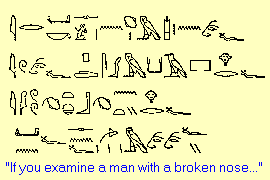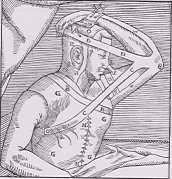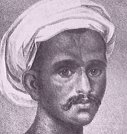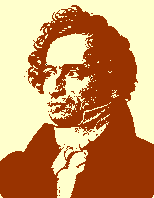
Introduction
Ancient history
Modern history
Traditional operation
Open rhinoplasty
Template rhinoplasty
Alar base reduction
Septal surgery
Implants
Revisions
Cartilage grafts
Bone grafts
Problems
|
Ancient History
600 BC
Egypt
| Nasal surgery was mentioned in hieroglyphs. |
 |
India
Amputation of the nose was a frequent form of punishment for such crimes as adultery.
Susruta Samhita described the reconstruction of the nose with a
flap of skin brought down from the forehead in his book,
Ayir-Veda.
1450 AD
Sicily
A family known as Branca used forehead flaps to reconstruct noses
and Antonio Branca used a flap of skin from the upper arm.
1597 AD
Italy
| Gaspare Tagliacozzi, Professor of Anatomy and Medicine in
Bologna and the ancient father of plastic surgery, described the
operation of upper arm nasal reconstruction in his book, De
curtorum chirurgia per insitionem, libri duo published in
Venice, 1597. At the time it was regarded as heresy to repair the
human form because deformities were an act of God. He was
persecuted and eventually his body was reburied in
non-consecrated ground. |
 |
1794 AD
India
| A story was published in the Madras Gazette (and
later in the Gentleman's Magazine, London, October 1794)
about an Indian bullock driver with the English army named
Cowasjee who had his nose and one hand amputated by Sultan Tippoo
during the war of 1792. The nose was reconstructed one year later
by a man of the brick maker caste near Poonah. The operation was
not uncommon in India and had been practised from time
immemorial. A thin plate of wax is fitted to the stump of the
nose so as to make a nose of good appearance. It is then
flattened and laid on the forehead where a line is drawn around
it. The forehead flap is cut with a razor, turned down and
inserted into an incision to form the nose. The connecting slip
of skin is divided about the 25th day. |

Cowasjee
|
1814
London, England
| Joseph Carpue, F.R.C.S., used the Indian method of nasal
reconstruction on an in his Majesty's army on 23rd October at
York Hospital, Chelsea. The operation took a quarter of an hour
(9 minutes dissection , 6 minutes ligatures) and the patient
observed that, It was no child's play - extremely painful -
but there was no use in complaining. Carpue wrote that the
new nose has every appearance of a natural nose.... The
forehead was healed in three months. |
 |
1845
Germany
| Johann Dieffenbach, born 1792, opened his
medical practice in Berlin in 1823 and had an interest in plastic
surgery from the start. As Professor of Surgery at Berlin
University he published a Textbook, Operative Surgery,
in which he described the first aesthetic reduction of a large
nose. He used external incisions. |
 |
Back to Top
|




